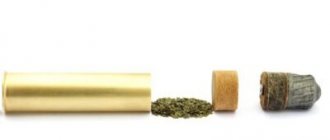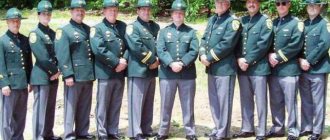What is a arquebus, its creation
The development of firearms went in several directions. Manufacturers of those times sought to create more and more advanced designs. At the same time, the craftsmen tried to make them mobile and easy to handle, non-bulky and durable. As a result, a whole class of hand and siege weapons appeared, which in Rus' were called arquebuses.
What a arquebus was was known mainly in Rus'. This was the name given to early examples of weapons with a barrel of medium or long length. This parameter was determined both by the skill of the manufacturers and the specifics of the order. It was customary to arm cavalry troops with long-barreled weapons and infantry with short-barreled arquebuses.
The meaning of the word “pishchal” comes from the concept of “pipe” and was first mentioned in Old Slavonic sources from the eleventh century, and applied to weapons - approximately from 1400.
It is also necessary to note the different sizes of the arquebus. There were hand and fortress guns that were much larger in size and weight, which reduced their mobility and made them more similar in appearance to classic cannons.
Squeaked in use
The food for hunting birds and small animals was 6 mm in caliber; the average ones are 8-10 mm, the most of them have been preserved. The largest, “bestial” squeaks had a caliber of 17-18 mm, they were also called “big bullet”. In addition to rifled pikes, there were pikes with a smooth bore. They could fire both shot and bullet. Following European fashion, Russian craftsmen made sets of two flint arquebuses - with a rifled barrel and a smooth one.
In the Russian army there were “stirrupya streltsy” - horsemen who moved on horseback along with the rest of the cavalry, but dismounted to support it with fire. They were armed with lighter and shorter arquebuses, usually with a European-style barrel, but with the same Asian matchlock. Such arquebuses were called curtained, as they had a carrying strap and, when moving on horseback, were thrown (“hung”) behind the back.
The barrels of the arquebuses were welded from ordinary iron strip or from the so-called forged “red iron”. On the surface of the “red iron” trunks, an intricate pattern of curls and lines can be seen. This pattern was achieved using special forging. The iron strip for the barrel was pre-welded from twisted wire rods of various qualities. Then this strip was heated and wound onto a mandrel, turn by turn. Each turn was carefully boiled. During one heating it was possible to connect 2-3 turns. Once the barrel was "drilled", it was drilled from the inside and polished. Then they filed and polished the outside. Then they etched the surface with acid so that the patterns obtained during welding appeared. Russian gunsmiths used a similar method of making barrels already at the beginning of the 17th century, earlier than in Europe.
The flint arquebuses made in the Armory for the royal court were of high quality and intricately decorated. The trunks were carved and covered with gilding and silvering. The breech often featured a double-headed eagle under a crown - as a state symbol. The locking boards were gilded, the triggers and flints were made in the form of fantastic monsters or animal heads. The stock used first-class wood. They were also richly decorated using various techniques - carving, inlay, and notching.
Among the hunting flint arquebuses that belonged directly to the royal person, the “small pulka” arquebus and the hunting arquecal, dated 1692, stand out - both of Tsar Peter Alekseevich. The first arquebus has a gold inscription on the upper edge of the barrel, which indicates that it belongs to Tsar Peter Alekseevich and the date 1688. The arquebus is made for bird hunting with a rifled bore of a 6-mm caliber barrel. Its dimensions are small - the total length is about 115 mm, and the barrel length is 83 mm.
Sagittarius with arquebus
The second arquebus is equipped with a silvered inscription on the upper edge of the barrel. It indicates the owner - Tsar Peter Alekseevich and the date 1692. This arquebus has much larger dimensions than the first - the total length is almost 138 mm, and the caliber is 9 mm. The decoration of the barrel and stock combines mascarons borrowed from Western European ornaments, figures of people in European dress and Russian double-headed eagles, unicorns and sirens.
The Russian squeaks did not have exact European analogues, occupying an intermediate position between the arquebus and the musket. In the middle of the 16th century, with the advent of granular (“grained”) gunpowder, in contrast to powder pulp, which did not stick to the walls of the bore and did not require long-term hammering of the charge, the rate of fire of arquebuses increased slightly. In the 17th century, squeakers began to be equipped not with a matchlock, but with a more convenient flintlock, but the name “squeaker” for new guns was retained until the military reforms of Peter I, when old-style small arms were replaced in the army, first with muskets and then with European-style fuses. However, squeaks continued to be in service with the Cossacks and militias until the end of the 18th century.
Hand arquebus
What is a hand pike? This is a weapon for close combat, or rather, direct fire contact with enemy forces. It had a small caliber, which was due to the need for hand-held fire and long-term transport when troops were on the march.
The arquebus could conduct effective fire at a distance of about three hundred meters, but the lack of sighting devices made the firing accuracy mediocre. The rate of fire was also low, and reloading took a long time, as it was a labor-intensive process.
It took time and skill to prepare a arquebus for shooting, so in this regard there was a big difference between beginners and experienced shooters. When conducting combat operations, the main method was volley fire, and it had to be made as dense and effective as possible. Combat tactics - linear formations of shooters, provided a larger number of guns in a salvo.
Excerpt characterizing Pishchal
Princess Marya knelt in front of her and hid her face in the folds of her daughter-in-law's dress. - Here, here - do you hear? It's so strange to me. And you know, Marie, I will love him very much,” said Lisa, looking at her sister-in-law with sparkling, happy eyes. Princess Marya could not raise her head: she was crying. - What's wrong with you, Masha? “Nothing... I felt so sad... sad about Andrei,” she said, wiping her tears on her daughter-in-law’s knees. Several times throughout the morning, Princess Marya began to prepare her daughter-in-law, and each time she began to cry. These tears, the reason for which the little princess did not understand, alarmed her, no matter how little observant she was. She didn’t say anything, but looked around restlessly, looking for something. Before dinner, the old prince, whom she had always been afraid of, entered her room, now with a particularly restless, angry face, and without saying a word, he left. She looked at Princess Marya, then thought with that expression in her eyes of attention directed inward that pregnant women have, and suddenly began to cry. – Did you receive anything from Andrey? - she said. - No, you know that the news could not come yet, but mon pere is worried, and I’m scared. - Oh nothing? “Nothing,” said Princess Marya, looking firmly at her daughter-in-law with radiant eyes. She decided not to tell her and persuaded her father to hide the receipt of terrible news from her daughter-in-law until her permission, which was supposed to be the other day. Princess Marya and the old prince, each in their own way, wore and hid their grief. The old prince did not want to hope: he decided that Prince Andrei had been killed, and despite the fact that he sent an official to Austria to look for his son’s trace, he ordered a monument to him in Moscow, which he intended to erect in his garden, and told everyone that his son was killed. He tried to lead his previous lifestyle without changing, but his strength failed him: he walked less, ate less, slept less, and became weaker every day. Princess Marya hoped. She prayed for her brother as if he were alive and waited every minute for news of his return. “Ma bonne amie, [My good friend,”] said the little princess on the morning of March 19th after breakfast, and her sponge with mustache rose according to an old habit; but just as in all not only smiles, but the sounds of speeches, even the gaits in this house since the day the terrible news was received, there was sadness, so now the smile of the little princess, who succumbed to the general mood, although she did not know its reason, was such that she reminded me even more of general sadness. – Ma bonne amie, je crains que le fruschtique (comme dit Foka – the cook) de ce matin ne m'aie pas fait du mal. [My friend, I’m afraid that the current frishtik (as cook Foka calls it) might make me sick.] - What’s the matter with you, my soul? You're pale. “Oh, you are very pale,” said Princess Marya in fear, running up to her daughter-in-law with her heavy, soft steps. - Your Excellency, should I send for Marya Bogdanovna? - said one of the maids who was here. (Marya Bogdanovna was a midwife from a district town who had been living in Bald Mountains for another week.) “And indeed,” Princess Marya picked up, “maybe, for sure.” I will go. Courage, mon ange! [Don't be afraid, my angel.] She kissed Lisa and wanted to leave the room. - Oh, no, no! - And besides the pallor, the little princess’s face expressed a childish fear of inevitable physical suffering. - Non, c'est l'estomac... dites que c'est l'estomac, dites, Marie, dites..., [No, this is the stomach... tell me, Masha, that this is the stomach...] - and the princess began to cry childishly, painfully, capriciously and even somewhat feignedly, wringing his little hands. The princess ran out of the room after Marya Bogdanovna. - Mon Dieu! Mon Dieu! [My God! Oh my God!] Oh! – she heard behind her.
Multi-barreled weapon
History has also preserved stories about multi-barreled arquebuses, which in theory had a huge fire density and considerable destructive power. They were designed to compensate for low accuracy. The design of this type of weapon made it possible to fire from a larger number of barrels, which increased both the damage caused and the chances of hitting the target.
The shells and bullets of multi-barreled arquebuses had different sizes, and the greatest effectiveness was achieved against crowds of people. There are many opinions regarding their size, but not a single example of a weapon has survived to this day.
Si vis pacem, para bellum!
10/21/2015 Russian squeak guns with their own names
Tweet
In XIV Russia, all firearms were called arquebuses . In principle, the differences were only in the diameter of the barrel (caliber) and, accordingly, in the weight of the weapon.
The word “pishchal” has been known in Slavic sources since the 11th century and is associated with the verb “squeak.” Its original meaning is “pipe”, “pipe”.
The division of pikes occurred at the end of the 15th century, when the matchlock was invented and portable hand pikes appeared.
Pikes were divided into two main types: hand-held and tools. Hand-held squeaks (undersized, self-propelled, hand-held) were carried by a soldier over his shoulder on a belt or transported in a baggage wagon.
Weapons were divided into fortress, siege, regimental and field weapons. Field arquebus guns were transported on wheeled carriages. Serfs were installed on the walls. They were mounted on tripods, carriages, or directly on the fortification itself.
They were also divided according to the materials from which they were made: iron, copper, bronze and cast iron. They were made by casting, using technologies that were used to cast bells for churches.
These squeaks were loaded with chopped metal, stone buckshot, and cannonballs. The caliber of guns was very diverse and was not subject to any systematization. There were about 60 calibers - from 30 to 250 mm.
In those days, guns were piece goods, and they were often given their own names.
The first mortar (a weapon for conducting mounted fire at an enemy hiding behind the walls of a fortress) of enormous size, which was called the Kashpirova cannon, was cast in 1555 by the Lit. Kashpir Ganusov. She shot with “shot” - stone buckshot, as well as large stone cannonballs.
In the same year, another Moscow master, Stepan Petrov, cast a slightly smaller, but also considerable mortar, which he named Pavlin. Both of these guns lay on the ground near St. Basil's Cathedral, which was under construction, and guarded the approaches to the bridge over the moat at the Spasskaya Tower in Moscow.
Among the famous arquebuses that have survived to this day is the siege “Inrog” (Unicorn), now located in the artillery museum in St. Petersburg, which was cast in 1577 by Andrei Chokhov, a famous litz master who worked at the Moscow Cannon Yard. There was an inscription on the barrel of the gun: “By order of Tsar Ivan Vasilyevich, this Inrog arquebus was made in the summer of seven thousand eighty-five (1577), made by Andrei Chokhov.”
There are also many more works by this master, and they all have their own names: “Aspid”, “Troilus”, “Wolf”, etc.
But its most famous weapon is the famous “Tsar Cannon”, installed on the territory of the Kremlin. It was cast by Andrei Chokhov in 1586. This cannon, firing stone cannonballs, was planned to be used to protect the Moscow Kremlin.
There is a legend that the Tsar cannon was never used in practice. But this is only a legend - in 1980, during restoration, the “Tsar” was examined by specialists from the Artillery Academy named after. F.E. Dzerzhinsky. Traces of gunpowder were found inside the gun; the gun had been fired at least once. However, documents indicating the use of “Tsar” have not yet been found. That is why there is debate about the possible date of the shooting.
But, despite all the disputes regarding its purpose and use, everyone agrees that the Tsar Cannon is one of the largest weapons created by mankind, and the largest in caliber to survive (890 mm).
Another skilled person was Semyon Dubinin. His famous weapon, the “Scroll,” had a length of about 4.5 meters and a caliber of about 200 mm.
Another gun of the master, which was the first prototype of a wedge bolt, is also in the artillery museum of St. Petersburg. It was made in a unique way. The gun was forged into one piece from three cast pipes. The places where the chains were forged had the appearance of snake mouths biting the tail of the previous snake, hence the name “Three Asps”. The arquebus was cast specifically for the Joseph-Volokolamsk Monastery. Its caliber is 45 mm, length 4.9 meters, weight 162 kg.
But on the first attempt to fire, the gun jammed. The mass of the powder charge was incorrectly calculated, and the lead core got stuck in the bore.
Squeak guns were in service with the Russian army until the 17th century.
For some reason this photo reminded me of a photo wallpaper. And photo wallpaper is a modern and popular type of decoration; it is better to buy it at https://www.mirpola.kiev.ua/photooboi-c-1381.
Materials used: https://www.pnevmach.ru/car-pushka-istoriya-neispolzuemogo-oruzhiya.html
photo: https://www.hellopiter.ru/Art_ellerijsky_museum.html
Related publications:
- Russian women warriors
Posted in Weapons and tagged squeak guns
The primitive device of the squeak
The design of the arquebus was very simple and even artless. It was an iron tube or barrel, at that time still smooth, without rifling, mounted on a wooden base.
It was called a stock, and at the back it turned into a butt. Some arquebuses had a funnel-shaped bell on the trunk. The calibers were great. This was explained both by the complexity of manufacturing and the impossibility of carrying out work with small dimensions, since the technology did not allow this.
The most common caliber is 20-30 mm, the barrel is 80-110 cm long, the handle is 110-140 cm, the weight of the arquebus is 5-7 kg. The trunks were mainly made of iron. In the front part the arquebus had a persistent metal rod.
This was done due to the considerable weight of the weapon and the impossibility of keeping it suspended for a long time. The shot was carried out by igniting a powder propellant charge. Not all shots had the same force, since the size of the gunpowder charge was determined by eye.
Subsequently, the history of the development of this type of weapon followed the path of lighter weight and increased accuracy. This led to the fact that pikas gradually became rifles and muskets.
This strange word "squeaker"
Timofey Luchaninov's squeak butt (collection of the Armory Chamber of the Moscow Kremlin Museums).
However, by assimilating someone else’s, passing the new through the mind and heart, they do not copy blindly, but create their own, unique, what we proudly call Russian work, Russian invention and Russian style. It’s the same with language - there are many directly borrowed terms, but there are also those reinterpreted in their own way.
The Russian word "pishchal", meaning the oldest firearm in Russia, comes from the Czech word "pishtala". In Czech it meant a long pipe, and apparently its shape allowed the term to be applied to firearms. Likewise, “trunk” simultaneously refers to the trunk of a tree and the barrel of a firearm. Apparently due to the cylindrical shape of both objects.
At first, only artillery guns were called arquebuses, but in the 17th–18th centuries. with various clarifications (manual, screw, arquebus “undersized”, arquevo “small bullet”, etc.) they began to call hand-held firearms of the “gun” type.
Since the 17th century they began to make squeaks with flintlocks. A flintlock is essentially the same lighter, but simpler, without a wheel. The flint, clamped in the jaws of the trigger, struck the steel flint and struck sparks. Flintlocks were first given the name “schnaphans” in Europe, which roughly translates to “striking hammer.”
Before firing, a bullet and gunpowder were placed into the barrel of the gun; the seed powder was poured onto the shelf, the flint was lowered forward, and the trigger with the flint was pulled back. In the firing position, the trigger was held by a special part - the sear. When you press the trigger, the sear releases the trigger, and it hits the flint. This scheme of operation of a flintlock lasted for three centuries.
In Rus', flintlocks “shnaphans”, or rather weapons with them, were called self-propelled guns. The word perfectly reflects the essence of a flintlock squeaker - “it shoots itself.” Indeed, a loaded self-propelled gun can fire itself if the trigger accidentally falls off the cocking mechanism. The word “samopal” was first recorded in a chronicle of 1581, which describes the siege of the Russian city of Pskov by the troops of the Polish king Stefan Batory. The same word was found in the dictionary of French sailors who visited the mouth of the Northern Dvina in 1586, which they compiled to communicate with local residents. These written sources are indisputable evidence of the presence of firearms among the inhabitants of the Russian North, moreover, a spark system and, apparently, locally made.
In addition to written sources, we have well-preserved Russian-made shnaphans on guns from the Trinity-Sergius Monastery of the early 17th century. These are the most ancient of the surviving Russian rifle castles.
Gunsmiths in European countries made flintlocks slightly differently, which is why there are several different types of flintlocks. Dutch, Scots and English were roughly the same thing constructively. The Dutch castle was brought to Russia by gunsmiths who were invited to work by the Russian Tsar. The castle began to be called “Barabor”, distorting the sound of the word “Brabant” (Brabant is one of the provinces of Holland). The difference between the Scottish castle (“sheet”) was a different shape of the trigger, fastening of the jaws and the shape of the key board. The English lock became a subtype of the Dutch one, but with a safety catch - a “dog” that locked the trigger.
As a result of industrial contacts with gunsmiths from Europe, Russian craftsmen mastered all foreign designs and even began to make some hybrid designs. This is how the “Anglo-Dutch” castle of Russian design appeared. In documents of the 17th century. it is often referred to as the "castle for the English cause." It was placed on ceremonial and hunting weapons by Russian gunsmiths in the middle and second half of the 17th century.
The manufacture of weapons in Russia has always been a “sovereign matter.” But not only war required guns and sabers. Hunting was an important area in the life of the Russian tsars. It made it possible not only to enjoy the process itself, to engage in a duel with the beast, to track down the bird and kill it with a well-aimed shot. The royal hunt allowed the sovereign to show himself off to foreign ambassadors, demonstrate the wealth and splendor of the royal retinue, and show off weapons, horses and birds of prey. During the hunt, as at a ceremonial reception, contracts were concluded, gifts were presented, guests were lavishly, with Russian panache, treated to exquisite game dishes on silver and gold dishes.
In the 17th century, the life of the Russian state was concentrated in Moscow and outside the walls of the Kremlin, in the Armory Chamber. The hunting of the Moscow sovereigns was served by two “paths”, which were later renamed “orders” - Lovchiy and Sokolnichiy. A huge staff of servants was involved in hunting grounds, breeding and maintaining hunting dogs and birds of prey, and pens for wild animals. The service here was considered honorable, and was headed by the king’s closest relatives or his trusted people.
When royal hunts were unofficial, then the accompanying retinue was insignificant. If the hunt was carried out for the entire royal family with the invitation of foreign diplomats and guests, then the departure was distinguished by special solemnity and a large retinue. At the head of the procession rode armed horsemen, who were given sabers, squeaks and other weapons from the Armory Chamber. Behind them were the sovereign's Armory Treasury, where especially valuable weapons were placed in cases made of expensive, beautiful fabrics. Also on the “royal train” were thoroughbred horses in ceremonial attire. The procession aroused delight and admiration for its wealth, brightness of outfits and large numbers.
Weapons for the royal hunt were handled by the masters of the Armory Order, who worked in the Armory Chamber of the Moscow Kremlin. Along with military models, the production of ceremonial hunting weapons, in particular flint arquebuses, became paramount. According to the tsar's decrees, the best craftsmen - gunsmiths, engravers, stock makers, locksmiths, and assemblers - were gathered into the Armory from all the cities of the country. Local princes were reluctant to part with their “lefties,” but no one dared to disobey the royal decree. Gunsmiths were also invited from abroad, as well as Russian craftsmen, as part of embassy expeditions, traveled to other countries to see and learn.
Along with flint squeaks, there were carbines. The word “carbine” came to us along with other military terms from Europe. It meant a small gun of small caliber. There were both military and hunting carbines. Squeaks and carbines had barrels with 4-, 6- or 8-screw rifling. First they made straight cuts. When it turned out that the bullet flies more accurately from a barrel with screw rifling, they were preferred.
The food for hunting birds and small animals was 6 mm in caliber; the average ones are 8-10 mm, the most of them have been preserved. The largest, “bestial” squeaks had a caliber of 17-18 mm, they were also called “big bullet”. In addition to rifled pikes, there were pikes with a smooth bore. They could fire both shot and bullet. Following European fashion, Russian craftsmen made sets of two flint arquebuses - with a rifled barrel and a smooth one.
The barrels of the arquebuses were welded from ordinary iron strip or from the so-called forged “red iron”. On the surface of the “red iron” trunks, an intricate pattern of curls and lines can be seen. This pattern was achieved using special forging. The iron strip for the barrel was pre-welded from twisted wire rods of various qualities. Then this strip was heated and wound onto a mandrel, turn by turn. Each turn was carefully boiled. During one heating it was possible to connect 2-3 turns. Once the barrel was "drilled", it was drilled from the inside and polished. Then they filed and polished the outside. Then they etched the surface with acid so that the patterns obtained during welding appeared. Russian gunsmiths used a similar method of making barrels already at the beginning of the 17th century, earlier than in Europe.
The flint arquebuses made in the Armory for the royal court were of high quality and intricately decorated. The trunks were carved and covered with gilding and silvering. The breech often featured a double-headed eagle under a crown - as a state symbol. The locking boards were gilded, the triggers and flints were made in the form of fantastic monsters or animal heads. The stock used first-class wood. They were also richly decorated using various techniques - carving, inlay, and notching.
In the first week after Easter, there was a tradition of presenting the best products of the craftsmen to the royal court. If the items were liked, the masters of the Armory Chamber were rewarded with cloth, taffeta, other goods or money. In the documents of the Armory Chamber (Expense Book of 1625) there is a record of how one of the best masters of the Armory Order, Timofey Luchaninov, upon returning from Persia, was granted pieces of Venetian taffeta and English cloth for the fact that he was sent there “to learn squealing and saber affairs".
While in Persia, Luchaninov saw with his own eyes the best work of the court gunsmiths of Shah Abbas I. Surely the Russian master meticulously studied everything - the barrels of arquebuses, the decor of boxes and castles, edged weapons, techniques and tools. After a trip to Persia, Timofey Luchaninov made a wondrously beautiful flint arquebus. The entire length of the steel barrel is decorated with a carved snake, the scales of which are silvered and gilded. The castle was built of the Anglo-Dutch type, which, as noted above, was often used by Russian craftsmen. It is decorated with an S-shaped trigger, and the shelf has a lockable lid. All details of the castle are decorated luxuriously and variedly: there is a floral ornament of “herbs”, animal heads, and a sea shell. The squeaker's bed is especially complex and impressively designed. The master used the technique of inlaying with different materials - mother-of-pearl, silver wire, nails and stars.
It is very rare if you can see the name of the master and the date of manufacture on a weapon of this time. On the flint arquebus, which will be discussed, two master gunsmiths are indicated - barrel maker Vasily Titov, locksmith Andron Dementyev and the date 1673. Vasily Titov was a student of the first-class master Grigory Vyatkin, who worked in the Armory Chamber. He wrote a petition to the sovereign, where he asked to take his talented student as a self-made master. The flint arquebus, which Vasily Titov and Andron Dementyev worked on, was made as a “tray” weapon for the sovereign just after Easter.
Among the hunting flint arquebuses that belonged directly to the royal person, the “small pulka” arquebus and the hunting arquecal, dated 1692, stand out - both of Tsar Peter Alekseevich. The first arquebus has a gold inscription on the upper edge of the barrel, which indicates that it belongs to Tsar Peter Alekseevich and the date 1688. The arquebus is made for bird hunting with a rifled bore of a 6-mm caliber barrel. Its dimensions are small - the total length is about 115 mm, and the barrel length is 83 mm. The second arquebus is equipped with a silvered inscription on the upper edge of the barrel. It indicates the owner - Tsar Peter Alekseevich and the date 1692. This arquebus has much larger dimensions than the first - the total length is almost 138 mm, and the caliber is 9 mm. The decoration of the barrel and stock combines mascarons borrowed from Western European ornaments, figures of people in European dress and Russian double-headed eagles, unicorns and sirens.
It would be very interesting to know about the combat capabilities of flint arquebuses. No one has carried out practical experiments with museum samples, nor with remakes. Let's try to draw some analogies.
At the end of the nineteenth century. In the settlement of Vorontsovka, Voronezh district, artisans made rifled rifles for commercial hunting. They were muzzle-loading, ramrod, with long barrels of small caliber - 6-8 mm. And in terms of design and combat qualities, they can be equated to “small bullet” flint squeaks.
According to contemporaries, with a Vorontsov rifle, a hunter could hit the head of a marmot at a distance of 100 meters, so as not to spoil the skin. True, they shot from point blank range, but for 140 shots there were only 15 misses! One can envy such accuracy.
The combat capabilities of flint muskets with a smooth bore can be imagined by comparing data on shooting from a smooth-bore musket with a caliber of 20 mm and a barrel length of 1200 mm, but with a matchlock. In Denmark in the 1930s, shooting was carried out from this sample - gunpowder was prepared according to a recipe from the beginning of the 17th century. and took a round bullet. At a distance of 150 m, the bullet pierced a board over 5 cm thick, and retained its destructive power up to 180 m.
Another fact testifies to the reliability of a shot from a flint weapon. At the very beginning of the nineteenth century. London gunsmith Durce Egg made flintlock weapons with flintlocks turned downwards. The precision of the mechanism was such that the seed powder managed to ignite the main charge at the moment when it fell from the shelf that was open downwards. Naturally, the gunpowder had to be of good quality, dry, and the flint sharpened. From the practice of the 18th century. it is known that the flintlock could fire up to 15 shots without misfiring. In the dexterous and skillful hands of a hunter or military man, who had a keen eye, who took care of and loved his weapon, the flint arquebus struck far and accurately.
1581 is the time of the first mention of flintlock guns in Rus'.
BARREL - MUSICAL INSTRUMENT
Although squeaks are “direct descendants” of cannons, their name comes from the Czech word “pishtala”, i.e. "long pipe" The origin of the word tells us where the pikas came from. Hunters often use the barrels of modern guns as signal pipes to collect dogs and stray comrades.
SCARY WORD - SHNAPKHAN
In German, Hahn has two meanings: cock and cock. The gun's trigger is shaped like a chicken's head. This is where its Slavic name comes from. And the first half of the word (schnap) comes from the German verb Schnappen - to snap and grab. This suggests that the shnaphan is a rooster holding a flint in its beak. Indeed, the trigger with a screw clamp looks very much like the head of a rooster grasping a loaded flint with its beak. To keep the flint firmly in the trigger, a piece of thick leather was placed between its “beak” and the flint.
LONG-LIVING WEAPONS
Flintlock guns have been in production for over three hundred years. Their simplicity and reliability led to their use by fishermen until the beginning of the twentieth century. In Siberia and in the north of the European part of our country, some hunters hunted with flint weapons. With the advent of percussion locks, some gunsmiths used flintlock barrels for new guns, caulking the ignition holes into them, since the production of barrels remained extremely difficult.
140 shots from a 19th century ramrod rifle and only 15 misses at a distance of 100 meters - even now for a tournament.
Yuri Shokarev November 29, 2011 at 00:00











